How to process currant and gooseberry bushes in the spring from pests and diseases
Gooseberry and currant shrubs are unpretentious in cultivation. Subject to simple rules of agricultural technology, they consistently give juicy and tasty fruits. Berries are used fresh, for conservation, drying, processing.
Experienced gardeners know that watering and fertilizing the plants regularly is not enough to get a rich harvest. It is also important to pay attention to protection from diseases and pests. What is the processing of currant and gooseberry bushes and which methods are the most effective, we will consider in the article.
The content of the article
How to process currant and gooseberry bushes in spring for preventive purposes
Diseases and pests appear on currant bushes and gooseberries for various reasons: unsuitable planting site, contaminated soil or seedlings, non-compliance with agrotechnical rules, sudden changes in weather. The best way to avoid diseases and unwanted insects is to take regular preventive measures. This can be spraying and processing bushes, the introduction of mineral mixtures or fertilization with folk remedies.
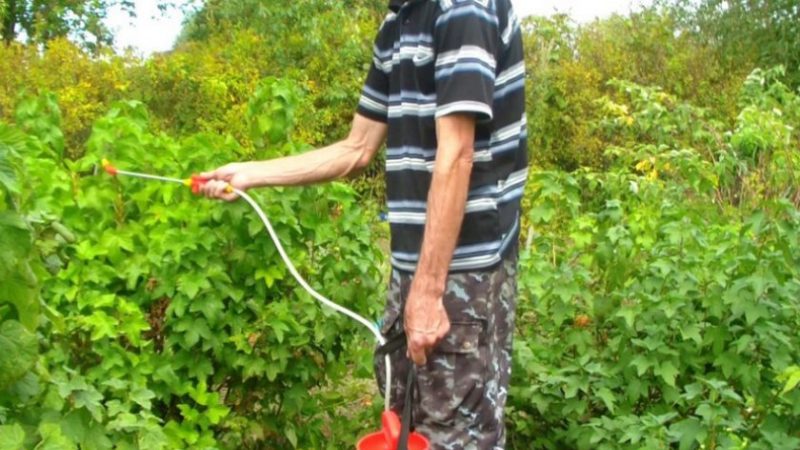
From disease
Preventive treatment for diseases carried out throughout the growing season - before and after flowering, in spring and autumn. The following methods are popular:
- In spring, the shrubs are watered with boiling water 1-2 times - it kills fungal spores and larvae of pests that hibernated in the ground. Boiling water is poured into the trunk circle, while it is important that water does not get on the shoots and leaves.
- Before budding, gardeners process plantings with a solution of ash (10 liters of water requires 2 kg of ash) or copper sulfate (7 liters of water - 15 g of substance).
- After budding, gooseberries and currants are treated with Bordeaux liquid. It is sprayed from a spray bottle at a distance of 20 cm from the bush.
- In autumn, gardeners remove all fallen leaves, dry branches, and weeds. It is important to properly prepare the bushes for wintering by removing all debris and preventing the development of dangerous microbes.
- Before planting, the planting material is disinfected - the seedlings are soaked for 15 minutes in water at a temperature of + 45 ° C.
From pests
Common pests of gooseberries and currants - aphids and caterpillars... Both larvae and adults are dangerous. To avoid the appearance of insects, at the beginning of summer the plants are treated with a solution of "Karbofos" (90 g is required for 10 liters of water). The second procedure is carried out 12 days after the first, using the drug "Kilzar". When using chemicals, it is important to observe the indicated dosages and the recommended processing times.
To take care of the fruiting of the bush next year, after harvesting the fruits, gardeners water the plants with tobacco infusion (for 10 liters of water - 400 g of tobacco dust). The popular folk method is also used: 4 kg of tomato tops are boiled in 10 liters of water, 50 g of grated laundry soap is added to the mixture. Shrubs are watered 1-2 times.
Attention! In addition to fertilizers, it is important to regularly take care of the cleanliness of the plantings, remove weeds, larvae, and other debris. It is also recommended to pay attention to the neighborhood of shrubs, not to plant them close to each other. It is better to place gooseberries and currants away from each other, since crops have the same diseases and pests.
Gooseberry and currant pests and control
Sometimes, even if all agrotechnical rules are followed, larvae or adult insects appear on the plants. Consider how to treat gooseberry and currant bushes in the spring from pests.
Mole
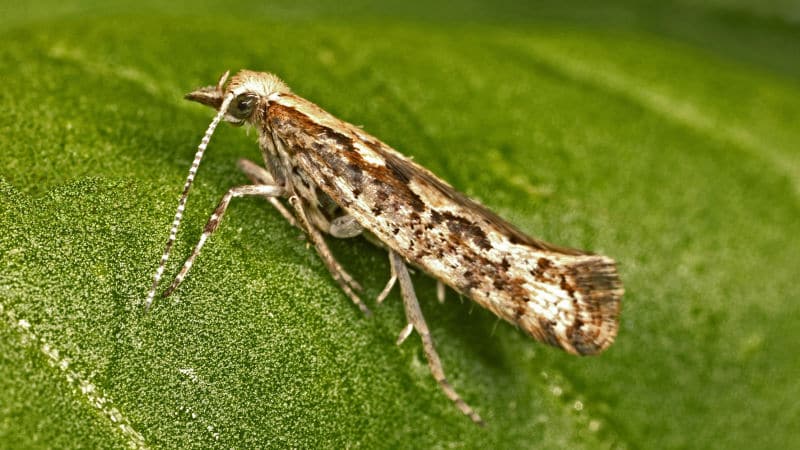
The moth damages gooseberries, red, white, black currants. The insect is small, looks like a small butterfly, it is difficult to see the moth with the naked eye. Depending on the variety, it is black, yellow, brown. Caterpillars are frost-resistant, winter in the ground, and come out with the arrival of spring.
The danger is posed by both larvae and adults. The moth is activated during flowering, affects leaves and shoots, because of this, the fruits are tied poorly. Leaves curl and wither, the plant looks sick. If measures are not taken in time, the moth will destroy up to 50% of all kidneys.
For preventive purposes, summer residents carry out the autumn pruning of gooseberries and currants, remove dry branches and leaves, thin out the crown of the shrub. During the period of swelling, the plants are treated with Fufanon. It is also recommended to pay attention to complex fertilizers and regularly remove weeds.
Aphid
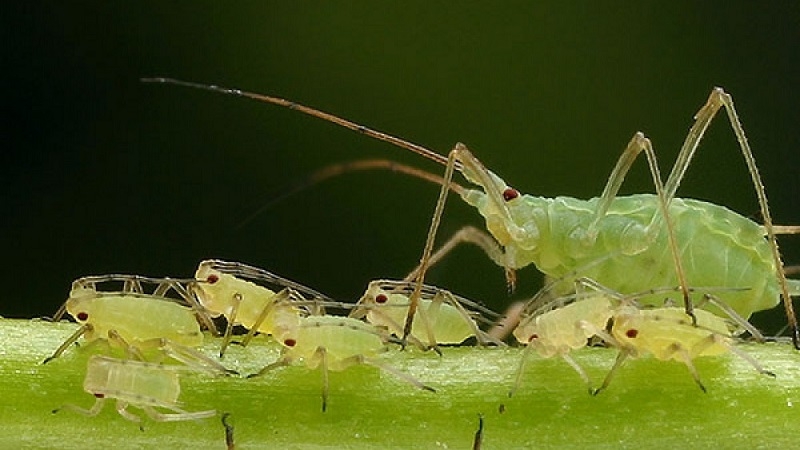
Small flying insect of white or pink color lives in flocks. One colony of aphids has up to 1000 individuals, so it is difficult to get rid of it. More than 400 species of aphids are known. The most dangerous for currants and gooseberries is gallic, or gooseberry.
The pest survives on the juice, which is sucked from the shoots and leaves. The latter curl, the crown dries up, loses its shape. Aphids prefer young shoots, so they can most often be seen on one- or two-year-old shrubs.
To fight, spraying with a solution of copper oxychloride or 0.3% "Karbofos" is used. It is recommended to alternate chemical treatments with folk remedies - the shrubs are watered with an infusion of blooming wormwood (0.5 buckets of grass are required per 10 liters of water).
Attention! Suitable conditions for the development of aphids are thickened shoots and leaves, where sunlight does not penetrate. It is important to regularly thin out and rejuvenate the shrubs. The procedure is carried out every season, even if there are no pests.
Fire
Moth is a type of butterfly, body length is no more than 3 cm. Moth is easy to recognize by the characteristic color of the wings - gray with brown spots, the edges are fringed. Caterpillars of the butterfly are small, green, with a black head.
The characteristic signs of the appearance of a moth are cobwebs, holes are noticed on the berries, the fruits change color. Moths feed on gooseberry and currant juice, one pest is able to suck the juice from 15 berries. For preventive protective purposes, gardeners use spraying with a solution of chamomile (50 g per 5 liters of hot water). The shrub is processed before and after flowering.
Also systemic insecticides are used for treatment - "Iskra" or "Topaz". The soil is cultivated in early spring and the aisles are covered with polyethylene. This method destroys not only the moth, but also the larvae of other pests.
Spider mite
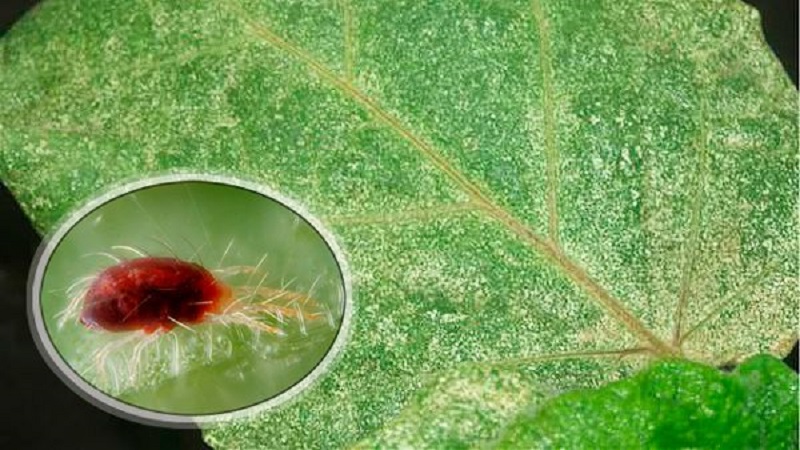
The spider mite appears in the garden in early spring and feeds on plant sap. It is easy to recognize it by the thin web that the insect leaves behind. But it is difficult to see the tick itself or the larvae - it is very small, the length does not exceed 0.5 cm. If measures are not taken in time, the shoots and leaves dry out and lose their color, become painful and weak.
The spider mite is frost-resistant, hibernates in the soil or axils of fallen leaves. A favorable environment for the spread of the pest is weeds and the remains of last year's plants. To combat spider mites, use tobacco or wormwood solution, as well as decoctions of garlic, onions, potato or tomato tops. From chemical methods, treatment with fungicides "Medea" or "Title" is used.
Attention! Fungicides are divided into single- and multicomponent, contact and systemic. It is important to follow personal safety rules when using fungicides. The treatment is carried out in gloves, a respirator and goggles.You can not apply fungicides 2 weeks before harvesting, it is better to give preference to folk methods of struggle.
Glass-maker
Of all the pest varieties, the threat to gooseberries and currants is currant glass. This is a butterfly that looks like a wasp in appearance: the body is fluffy, striped, yellow-black. The glass pot lives mainly on old shrubs, which are not regularly looked after.
The insect feeds on shoots, lays eggs in them and reproduces there. To protect the plants from the glass, it is important to regularly prune and shape the bush, remove old and diseased shoots, and burn them away from the garden area. After flowering, the bushes are treated with Iskra-M or Kemifos. Each bush requires about 1.5 liters.
Sawfly
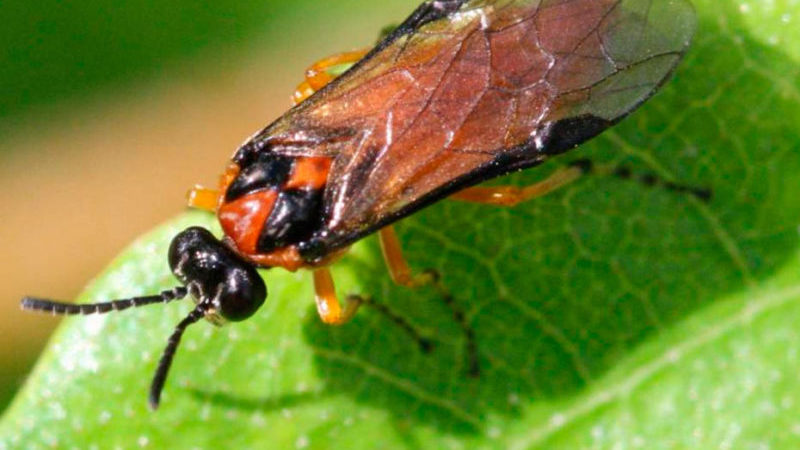
For currants and gooseberries, the gooseberry sawfly is dangerous. The pest is widespread throughout the regions of the country. The length of the beetle is 2-3 cm, the color is brown. It gnaws at the leaves of the plant, leaving only thin veins from them. After a few days, the bush begins to dry out, the fruits lose their shape and elasticity, fall to the ground.
There are several reasons for the appearance of sawflies: infected soil, weeds and debris, heavy or acidic soil. In the near-trunk circles, the plants are regularly loosened and mulched. In the fall, they begin to fight the pest: they dig up the earth, treat it with fungicides. In the spring, gooseberries and currants are sprayed with Iskra or Metaphos contact insecticide. The affected areas of the bush are removed and burned.
Moth
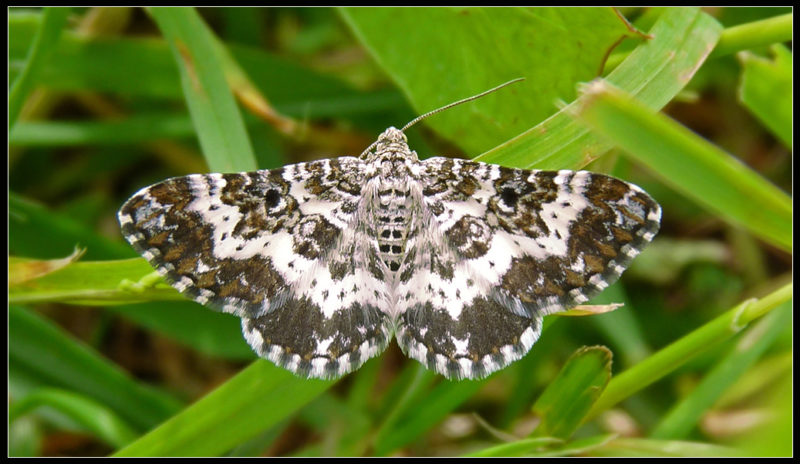
A large butterfly with yellow-white wings and a black pattern appears in the garden in the second decade of June. Females lay eggs between leaf veins, one individual is able to lay up to 300 pieces. During bud opening, young insects appear on leaves and shoots, eat them and draw out juices. Because of this, the shrubs dry out, the crown loses its shape, the branches weaken.
In addition to gooseberries and currants, the moth appears on pear, apple, apricot, and cherry trees. The insect is destroyed with the Kantor fungicide. From folk remedies, summer residents use spraying with a tobacco solution or infusion of nettle and wormwood.
Gallica
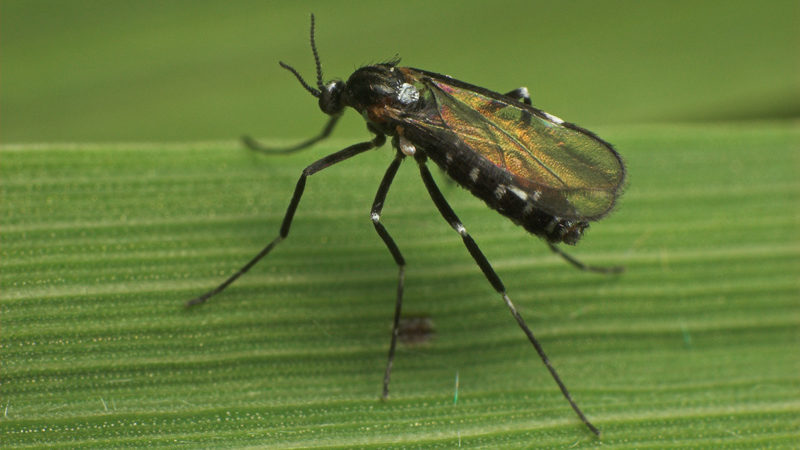
The harm is caused not by adult insects, but by larvae. Gall midge is widespread not only in Russia, but also in European countries. There are more than 6 thousand varieties. For gooseberries and currants, currant gall midge, a small winged insect of yellow-brown color, is dangerous. Outwardly, the pest resembles a mosquito, has the same antennae.
Gall midge loves young plants and is able to reduce yields by 70%. Planting is treated immediately after detection with the drug "Kemifos". It is dangerous for both larvae and adults. Root feeding from a mixture of ash and sand also helps to get rid of gall midges.
Attention! For the preventive purposes of the appearance of gall midges, gooseberries and currants are treated with vegetable infusion three times a year. For cooking, use tansy, chamomile, yarrow, calendula. 300 g of crushed flowers and leaves are poured into 10 liters of boiling water. Insist 24 hours and begin processing.
How to deal with gooseberry and currant diseases
Gooseberry diseases are viral, fungal, bacterial. Some arise due to high humidity or a sharp change in weather, others due to a lack of minerals or acidic soil.
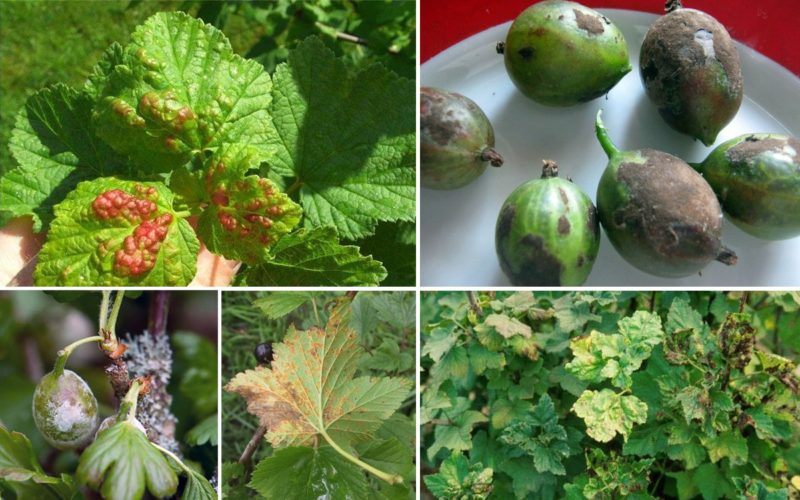
Powdery mildew
Powdery mildew refers to fungal diseases. It is easy to recognize it: leaves and shoots are covered white bloom, which in a few days passes into fruit. Shoots and berries are deformed, stunted and dry up.
Favorable conditions for the development of powdery mildew are rainy and hot summers, marshlands, fog and dew. Spores are carried by the wind and can infect other plants, so it is important to start fighting the disease in a timely manner.
Watering with hot water or spraying with Bordeaux liquid helps to destroy spores.For prolonged infection, chemicals are used - "Fitosporin" (7 ml per 5 liters of water) or "Topaz" (1 ampoule per 10 liters of water).
Rust
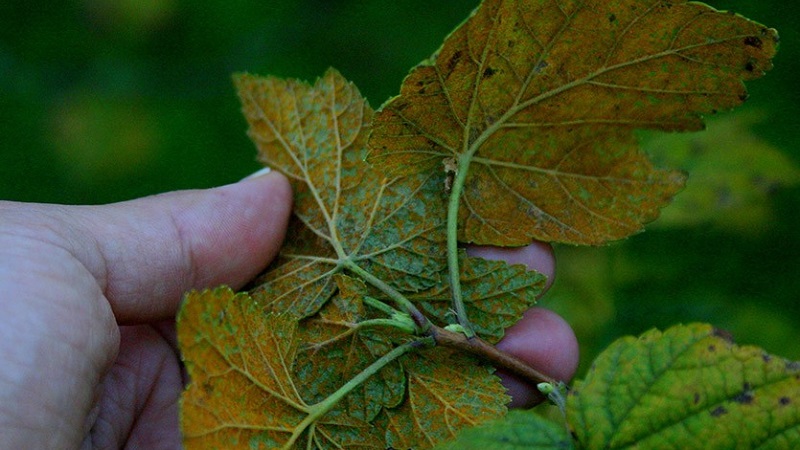
Glassy rust is dangerous for gooseberries and currants. It appears mainly in areas with acidic soil, affects shoots, leaves, roots, fruits and flowers of shrubs. Often rust occurs in early summer. Due to the disease, the fruits stop growing and are deformed, the shoots are bent. A fungal disease is treated with a mixture of copper sulfate and lime (400 g of lime accounts for 300 g of vitriol). Plants are treated in the morning or evening, after removing the infected areas.
Anthracnose

Anthracnose appears as brown spots that grow larger over time, causing the leaves to become dry. The growth of shoots decreases, ulcers appear on the old branches. Most often, anthracnose is found on gooseberry shrubs. The causative agent of the disease is fungal spores that overwinter in the soil. Anthracnose is especially active in rainy and cool summers.
It is recommended in early autumn to collect fallen leaves and burn it, and treat the bushes with a solution of copper sulfate. For treatment, gardeners use the fungicide "Captan". Processing is carried out 2-3 times over the summer. If measures are not taken in time, the disease will spread to other horticultural crops, and berry bushes will die.
Lichen and moss
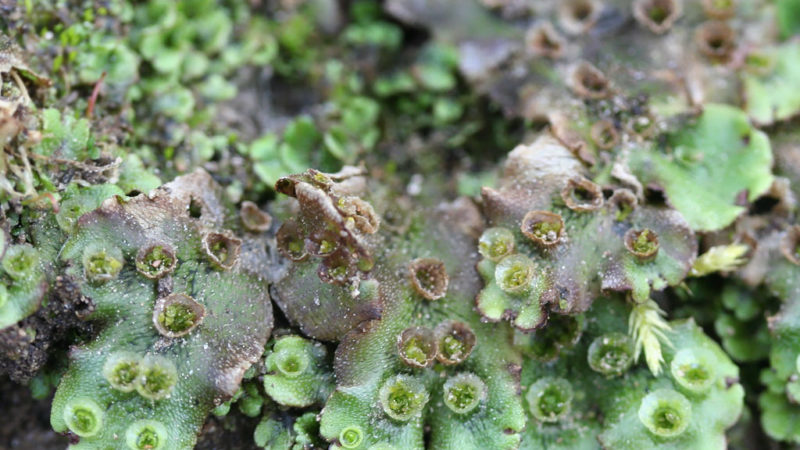
The lichen is a yellow-green growth on the bottom of the bush. Sometimes it also develops on the upper shoots. Lichen appears due to clogging of the pores of the plant, which is caused by wet weather. If lichen is found on currants or gooseberries, it is recommended to wipe the branches with a dry cloth and disinfect with a solution of copper sulfate. Summer residents also remove weeds, which can keep dangerous microorganisms on their surface.
Moss appears mainly on berries. They become covered with a gray dense bloom, lose their shape and juiciness. For preventive purposes, spraying with iodine solution is used (10 ml of iodine per 10 liters of water). Get rid of plaque with the systemic fungicide "Skor". It is effective and safe to use.
Conclusion
All horticultural crops need prevention and protection from diseases and pests. Gooseberries and currants are no exception in this case. They get rid of sawflies, aphids and gall midges by spraying with a solution of copper or iron sulfate; from anthracnose and powdery mildew - Bordeaux liquid.
A special place is occupied by fungicides - effective chemical preparations. The main thing is to detect the infection in time and take immediate action. To avoid the appearance of diseases and pests, gardeners regularly remove weeds, disinfect seedlings and soil before planting, do not plant shrubs at a distance of less than 3 m from each other.